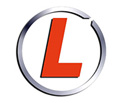 Trannies
101
Trannies
101
[Home] [About Us] [Used Vehicles] [Transmissions 101] [Why Leroux?] [Radio] [How to find us]
 Trannies
101
Trannies
101
At Leroux Brothers, we know transmissions. For nearly fifteen years, we've been hard at work repairing, rebuilding and modifying transmissions to work better, and last longer.An automatic transmission (we repair manual trannies as well) is one of the most complicated electro-mechanical devices on a modern vehicle. Made up of literally hundreds of specialized components, an automatic transmission utilizes hydraulic pressure, electro-mechanical valve switching, sophisticated computer control and a series of clutch plates and gears to match your vehicle's engine power to every possible driving situation. Here's a light duty truck transmission, almost completely disassembled in one of our shop benches:

Below is the Valve Body for the same tranmission:
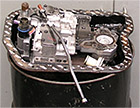
Dale Leroux's Torque Converter Tour
Below is a thorough pictoral essay on the function of the all-important TORQUE CONVERTER, with running commentary and description by Dale Leroux...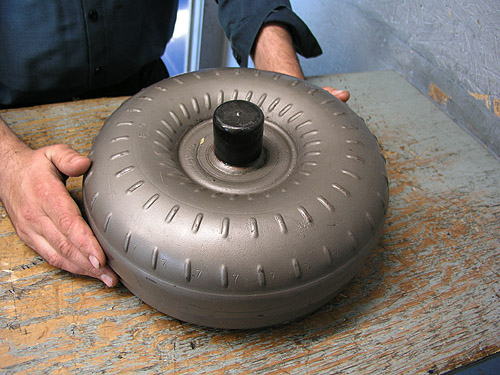
1. Here you have the complete torque converter,
with a plastic cap protecting the transmission pump drive slots.
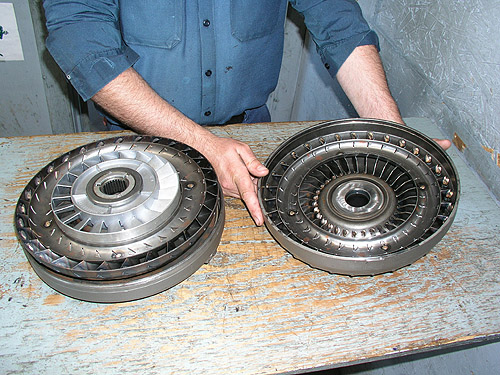
2. Opening the unit reveals two halves, with the torque converter's PUMP on the right.
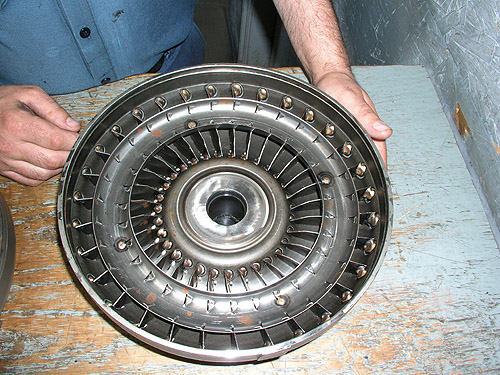
3. A closer image reveals the torque converter PUMP's vanes, which take the energy
of the vehicle's motor and transfers it to the hydraulic fluid present inside the torque converter.
4. On the other half of the converter, we now reveal the STATOR assembly, which sits on
the top of the TURBINE. This part of the torque converter takes the energy OUT of the hydraulic fluid and transfers the energy onto the automatic transmission's INPUT or TURBINE SHAFT.
5. This is the TURBINE. The vanes on the outer rims received fluid from the torque converter PUMP (see number 3 above) and transfer it to the center of the unit, the TURBINE SHAFT receptacle.
The torque converter utilizes centrifugal force to change it's hydraulic behavior. At low engine speeds, hydraulic fluid is sent via the STATOR back to the the converter PUMP. At high engine speeds, the STATOR revolves at the same rate as the entire torque converter. It is important to remember that the center of the STATOR features a one way clutch. This allows the STATOR to turn in only one direction, providing the automatic transmission with torque multiplication.
surface for theSTATOR SHAFT, the part that anchors the torque converter to the tranmission case.
9. A revealing look at the DAMPER assembly, in the center of the LOCK UP plate. The LOCK UP system allows the torque converter to become a mechanically "direct" link from the engine to the automatic transmission. Up until the point that the LOCK UP system becomes engaged, the link between the engine and the automatic transmission is purely hydraulic, via the torque converter.
10. The splines in the middle of the DAMPER assembly mate directly with the torque converter's TURBINE...
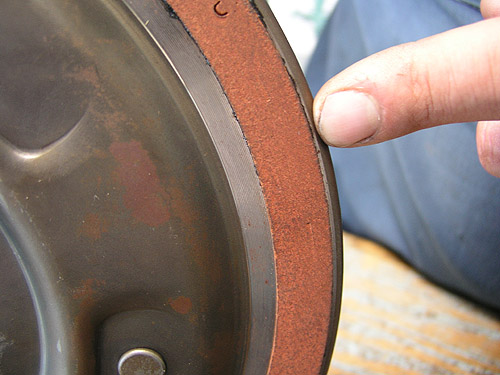
12. Detail of FRICTION PLATE that makes contact when LOCK UP is achieved.
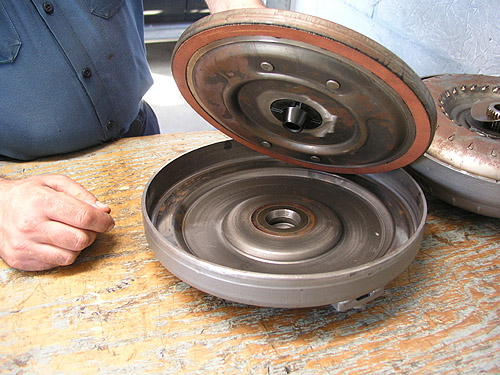
13. Under LOCK UP, excess hydraulic fluid is vented out of this chamber back into
the automatic transmission case through the center of the TURBINE SHAFT.
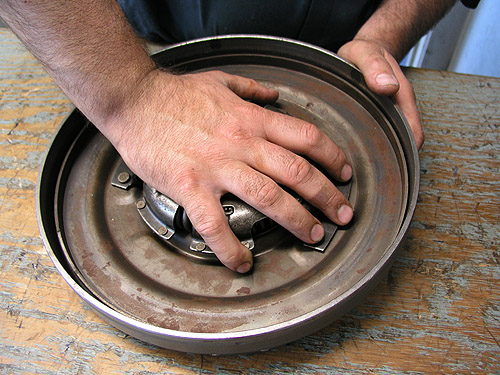
14. The remaining hydraulic pressure clamps the LOCK UP PLATE to the torque converter cover,
creating the near 1:1 friction lock up between engine crankshaft and automatic tranmission.
Form
more information, here's a great Link to
"HOW
STUFF WORKS", Automatic Transmissions
This is a 15 page tour de force, so
be braced. Clicking the link will take you
out of the Leroux Official Website,
so you're on your own!
(When you're done exploring, just
close the window to return to this page.)
[Home] [About Us] [Used Vehicles] [Transmissions 101] [Why Leroux?] [Radio] [How to find us]
copyright 2004-2007 Leroux Brothers, Inc. All rights reserved. rev111706